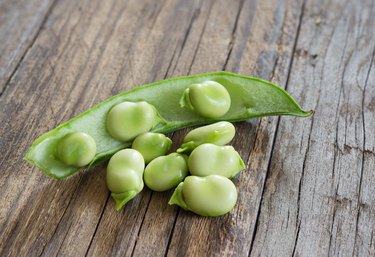
Many people with G6PD deficiency live their lives symptom-free. However, exposure to a few specific foods or substances can trigger serious side effects than can be life-threatening if left untreated. Fortunately, the restricted items on the G6PD food list are few and the G6PD diet is easy to follow. The most readily-available food that people lacking the G6PD enzyme should avoid is fava beans. A compound present in fava beans can cause hemolytic anemia in people who are G6PD-deficient. Speaking with your doctor at the onset of symptoms can prevent side effects from worsening.
Overview of G6PD Deficiency
Video of the Day
Glucose-6 phosphate dehydrogenase, or G6PD, is an enzyme that assists in the function of red blood cells. This enzyme reduces oxidative stress, which causes red blood cells to break down. People who lack G6PD can have a type of anemia called favism, or hemolytic anemia, when exposed to certain foods. Hemolysis is the medical term for the destruction of red blood cells. Hemolysis occurs much more quickly when people with G6PD deficiency consume a specific triggering substance that is found in some plants.
Video of the Day
Symptoms of G6PD deficiency don't present in individuals unless exposed to these chemicals, although infections and stress can also affect red blood cells. G6PD is a genetic disease linked to the X chromosome. It's more prevalent in males than females and is more common in the Mediterranean, the Middle East and Africa.
Hemolytic Anemia in G6PD Patients
Hemolytic anemia is a condition that occurs when the body lacks a sufficient amount of red blood cells because the cells are being destroyed at a faster than normal rate. Symptoms of hemolytic anemia include shortness of breath, rapid heartbeat, pale skin and dark urine. Over time, G6PD-deficient patients can develop an enlarged spleen, jaundice and skin ulcers if left untreated with continued exposure to triggers. Anemia can also have a number of effects on the cardiovascular system due to the decreased number of red blood cells.
G6PD Deficiency Foods to Avoid
The key to the G6PD deficiency diet is the avoidance of trigger foods. The primary food to avoid is fava beans. Consumption of any part of the fava bean plant can cause hemolytic anemia in G6PD-deficient individuals, including inhalation of fava bean plant pollen. Patients should use caution with gluten-free flours and products made from gluten-free flours as they may contain fava bean flour.
Because fava beans belong to the legume family, patients may also be advised to limit or avoid consumption of other legumes. Prior to the onset of hemolytic anemia, consumption of fava beans can also cause other acute symptoms, such as headache, dizziness, nausea and vomiting in G6PD-deficient individuals.
Avoiding Bitter Melon Products
The gourd-like bitter melon is another G6PD prohibited food and should also be avoided. The fruit of this tropical vine is a member of the cucumber family, but contains the same compound found in fava beans that can cause hemolysis.
Due to the bitter taste of the fruit, it's not commonly eaten, but supplements made from bitter melon are used to treat diabetes in parts of Asia, East Africa and South America. Bitter melon contains a polypeptide that acts like insulin to lower blood sugar.
Read more: Bitter Melon Disadvantages
Ascorbic Acid Supplementation
A 2017 case study published in Case Reports in Medicine examined that high doses of vitamin C can cause hemolysis in G6PD-deficient patients. High doses of ascorbic acid not only lead to the destruction of red blood cells in G6PD individuals, but can also interfere with the function of the red blood cells that remain.
Physicians often recommend or prescribe high doses of vitamin C for patients with high blood pressure, cancer, arthritis and other chronic diseases. While the authors did not warn patients against eating citrus fruits or other foods high in vitamin C, caution should be exercised when taking ascorbic acid supplements.
G6PD Deficiency and Diabetes
A Brazilian study published in 2014 investigated the prevalence of diabetes among G6PD patients. People with G6PD deficiency were more likely to exhibit a higher-than-normal fasting glucose level than people without the deficiency.
Read more: Things That Impact a Fasting Glucose Blood Test
Of the 140 people who tested normal for fasting glucose, 82 percent had normal G6PD, compared with only 17.9 percent of G6PD-deficient individuals. G6PD-normal individuals accounted for 29.3 percent of the 58 people with elevated glucose levels, while the G6PD-deficient individuals made up 70.7 percent of the people in the high-glucose category. These findings suggest that people who are G6PD deficient may benefit from following a diet geared toward managing high blood sugar and preventing the onset of diabetes.
- National Institutes of Health Genetic and Rare Diseases Information Center: Glucose-6-Phosphate Dehydrogenase Deficiency
- British Journal of Clinical Pharmacology: What G6PD-Deficient Individuals Should Really Avoid
- Cornell University College of Agriculture and Life Sciences: Vicine and Covicine
- Asian Pacific Journal of Tropical Disease: Antidiabetic Effects of Momordica charantia (Bitter Melon) and its Medicinal Potency
- Case Reports in Medicine: Effects of High-Dose Vitamin C in a Glucose-6-Phosphate Dehydrogenase-Deficient Patient
- The American Journal of Tropical Medicine and Hygiene: High Frequency of Diabetes and Impaired Fasting Glucose in Patients With Glucose-6-Phosphate Dehydrogenase Deficiency in the Western Brazilian Amazon
- Indiana Hemophilia and Thrombosis Center: G6PD